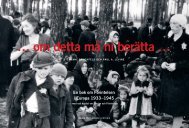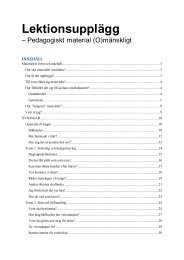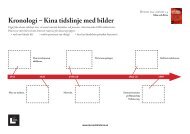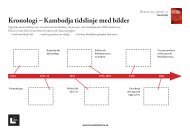Children…
Tell Ye Your Children... - Levandehistoria.se
Tell Ye Your Children... - Levandehistoria.se
- No tags were found...
Create successful ePaper yourself
Turn your PDF publications into a flip-book with our unique Google optimized e-Paper software.
The “Gypsies”<br />
During the Middle Ages, groups of Romani-speaking peoples<br />
came to Europe from Northern India via Persia, Asia<br />
Minor and the Balkans. Initially accepted, they were soon<br />
hounded by suspicion and prejudice. For example, they<br />
were often accused of being spies. For centuries Europeans<br />
could kill “Gypsies” with impunity: in Eastern and Central<br />
Europe, “Gypsy hunts” were sometimes organised, in<br />
which “Gypsies” were hunted down and killed like animals.<br />
Some Romani-speaking groups kept up their nomadic<br />
existence while others settled down, gradually assimilating<br />
into society. Eventually, they came to be regarded<br />
less as an ethnic group and more as a social group with<br />
low status. Even to this day, myths claim that they kidnap<br />
children, practise witchcraft and cause dangerous diseases.<br />
Antiziganism (hatred of “Gypsies”) remains deeply<br />
ingrained and widespread. Romani-speaking people<br />
are among the most targeted minorities in Europe, still<br />
enduring racist discrimination and violence.<br />
This picture, taken in Germany in the 1930s, depicts “Gypsy”<br />
life in a clichéd way. Many German “Gypsies” had already abandoned<br />
their nomadic ways and adapted to city life. Most German<br />
“Gypsies” were murdered by the Nazis during the war, and these<br />
children were probably among them.<br />
“Gypsies” and the racist state<br />
In the 1930s, there were approximately 1 million “Gypsies”<br />
in Europe, with some 30,000 living in Germany,<br />
either in caravans or in cities.<br />
By the beginning of the 20th century, a “Gypsy information<br />
bureau” was established in order to maintain<br />
a file on the whereabouts of German “Gypsies”. They<br />
were considered dangerous and declared a threat to be<br />
dealt with. Especially common were warnings against<br />
“race-mixing”. In 1905, a special chart was published<br />
with genealogical information and photographs of hundreds<br />
of German “Gypsies”.<br />
16
















